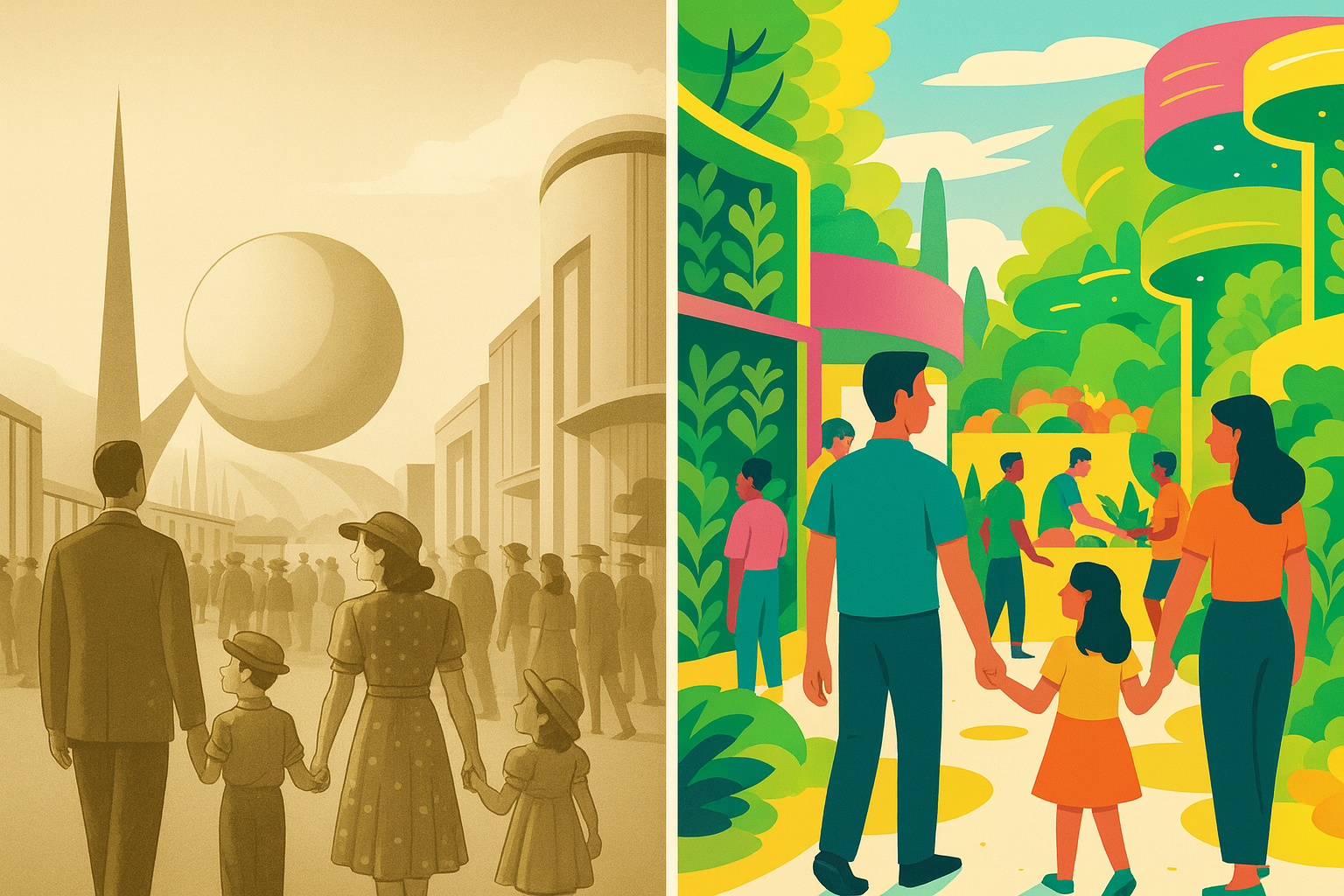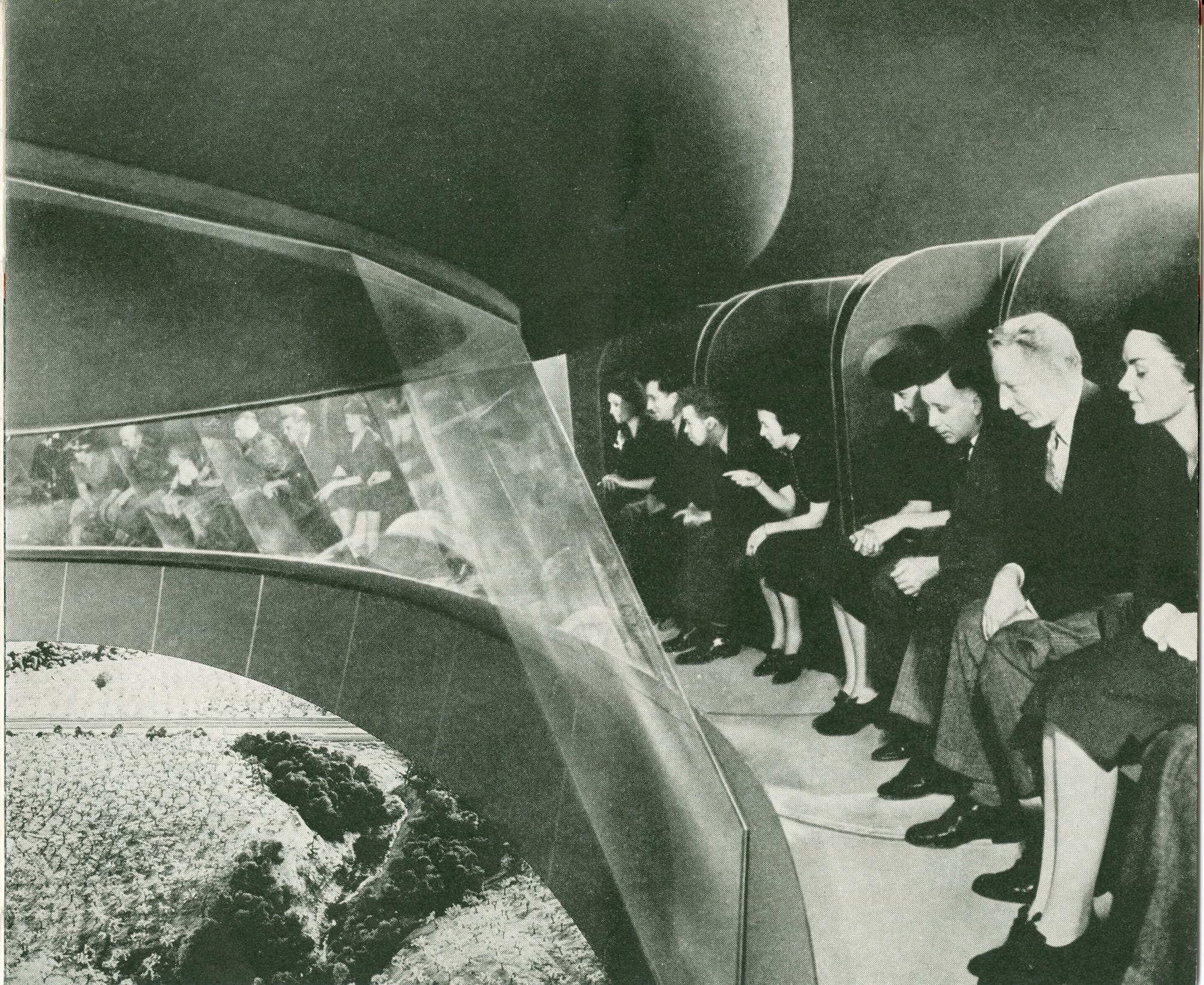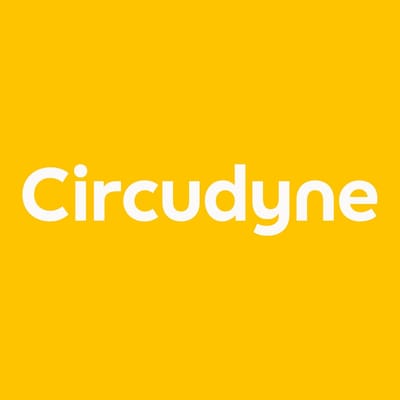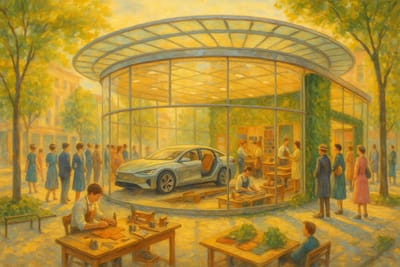Building Cultural Momentum

💬 Discuss this post: mention @christian@circudyne.com on Mastodon or your favorite fediverse app.
The Connection Domain
Last week in our letter about the Catalysts domain, we covered how circular economy gives purpose to sophisticated technology. This Letter explains why circularity also contains the elements of a powerful mythology—cultural narratives that, wisely applied, make transformation feel inevitable rather than optional.
By mythology, we mean the deep cultural stories that shape how people understand what constitutes a good life, meaningful work, and authentic progress—the frameworks that Douglas Holt calls "myth markets" where brands compete for cultural territory rather than just market share.
This opportunity is more profound than it might first appear. We are living in profoundly unhappy times. Even during the Great Depression, society possessed something we've lost after decades of technological progress: a shared vision of a better tomorrow.
The 1939 World's Fair drew 44 million visitors because they were ready to see what progress looked like. The Fair provided a communal rallying point around technological optimism that sustained hope through extraordinary hardship.
It’s fair to say producers and consumers are better off today. But despite how far we've come, we lack that unifying vision. We have innovation without narrative, disruption without direction, progress without purpose.
Happily, circular transformation contains all the mythological elements needed to restore shared purpose: regeneration over extraction, abundance over scarcity, connection over isolation.
We call this domain Connection because transformation flows through relationships—the cultural threads and human stories that bind people to new realities.
It confers on leaders the wisdom to read the currents of cultural momentum—how to access and activate the mythological ingredients that transform technological possibility into cultural inevitability.
Shared Experience and Mimetic Desire
The Connection domain in concert with Living Futures addresses why individual persuasion fails where shared experience succeeds. When people experience circular abundance individually, they question whether it's real or desirable. When they experience it collectively—surrounded by others having the same response—it activates mimetic desire: our fundamental tendency to want what others want, to become who others are becoming.
This is the operational principle that separates circular initiatives that scale from those that stagnate. René Girard's insight about mimetic desire explains why: humans don't derive desire from individual cost-benefit analysis but from observing what others desire.
We want things because other people want them. We adopt identities because other people embody them successfully. Desire is inherently social, not individual.
The Worldbuilding Connection
In Living Futures experiential prototypes where groups collectively inhabit circular abundance, it activates mimetic response. People share the company of other people wanting circular solutions that work.
This accelerates the adoption dynamic. Individual customers require rational persuasion about circular benefits. Communities experiencing circular abundance together create mimetic desire that makes adoption feel natural and inevitable.
The Connection domain maps how to access and amplify this mimetic power through cultural momentum mapping. Where Living Futures creates the shared experiences, Connection channels the cultural currents that carry circular transformation from proof of concept to social movement.
The Latent Demand Evidence
Two companies launch identical circular business models. One becomes a cultural phenomenon, the other struggles for adoption. The difference isn't technology or economics—it's cultural momentum.
Consider repair initiatives. Repair Café began in Amsterdam in 2009 as community events where neighbors fix broken items together. Today, over 2,500 locations operate globally, with waiting lists to join. Meanwhile, countless corporate "repair services" launch with superior technology, professional staff, and marketing budgets—only to close within months.
The technical capability is identical. The economic logic is identical. What differs is cultural positioning.
Repair Café tapped into mythological ingredients: community connection (neighbors helping neighbors), resourcefulness heritage (skills our grandparents took for granted), and resistance narrative (fighting planned obsolescence). Corporate repair services positioned themselves as convenience solutions, missing the deeper cultural currents.
Patagonia's "Don't Buy This Jacket" campaign demonstrates the same dynamic. While other outdoor companies launched sustainability initiatives with similar environmental benefits, Patagonia created cultural mythology around conscious consumption that made buying less feel like joining a movement rather than making a sacrifice.
Tool libraries show this pattern repeatedly. Successful locations become community hubs where sharing tools creates social connection and environmental impact. Failed initiatives focus on transaction efficiency—better inventory systems, streamlined checkout processes—without addressing the human desire for belonging and collective action.
The pattern is consistent: circular solutions succeed when they activate latent cultural aspirations.
These comparatively low-tech examples point to a larger opportunity. Latent demand for circular transformation exists everywhere. People want regeneration over extraction, abundance over scarcity, connection over isolation. They're waiting for circular solutions that feel like cultural movements rather than shopping decisions.
The Mythology Ingredients and Mimetic Activation
Circular transformation offers three powerful mythological ingredients that tap directly into mimetic desire—our fundamental human tendency to want what others want, to become who others are becoming.
Regeneration Over Extraction
The Mythological Power: Healing rather than harming positions actors as heroes rather than villains in their own story. When Yvon Chouinard gave away Patagonia to fight climate change, he embodied an archetype that others immediately wanted to emulate.
Mimetic Activation: Regenerative leaders become models of what successful, principled business looks like. Other entrepreneurs don't copy the specific tactics; they copy the identity. They want to be the kind of person who chooses healing over extraction.
Abundance Over Scarcity
The Mythological Power: Circular systems create expanding value pools rather than zero-sum competition. Interface Inc.'s Mission Zero demonstrated that ecological responsibility creates business abundance. Carbon-negative operations, reduced costs, premium positioning, employee engagement, customer loyalty.
Mimetic Activation: Business leaders see Interface's success and want to access that same abundance: the financial returns and the cultural positioning as regenerative innovators. They desire the identity of creating expanding value rather than extracting finite resources.
Connection Over Isolation
The Mythological Power: Ecosystem thinking replaces competitive isolation with collaborative advantage. The Buy Nothing Project creates hyperlocal gifting networks where neighbors share resources instead of shopping individually. This demonstrates Clayton Christensen's insight that market-creating solutions compete against non-consumption more than existing alternatives.
Mimetic Activation: Before Buy Nothing, the "competition" wasn't retail stores—it was neighbors not sharing anything at all. People lived without items they occasionally needed rather than buying them or borrowing from strangers. Buy Nothing creates abundance through connection where isolation previously created scarcity.
Members gain access to more things, and discover relationship-based prosperity that individual ownership cannot match. Families report that giving and receiving creates community bonds that extend far beyond the original exchanges. The mythology shift is profound: from "I need to buy everything I might use" to "I'm part of a community where we look after each other's needs."
Because Buy Nothing competes against non-consumption, it creates expanding value pools rather than zero-sum competition. Every gift strengthens the network. Every request builds relationships. This expanding value dynamic becomes the fuel for circular business models that choose to apply this activation. Traditional businesses extract value from scarcity; circular businesses amplify value through connection. Platform companies, sharing economies, and collaborative consumption models all depend on this principle: when connection creates expanding value, new revenue models become possible that couldn't exist within competitive scarcity frameworks.
This is why isolated circular initiatives struggle while cultural movements succeed. Individual solutions require rational persuasion. Cultural movements activate mimetic desire.
Douglas Holt's Cultural Mythology Framework reveals why these ingredients are so powerful. Holt argues that brands compete in "myth markets"—addressing the gap between how people currently live and how they aspire to live. Standard marketing focuses on product benefits, but successful cultural movements tap into deeper mythological tensions.
Circular transformation directly addresses three fundamental mythological gaps:
- Regeneration vs. Extraction: People want to heal rather than harm, but linear systems force extraction
- Abundance vs. Scarcity: People desire expanding possibilities, but competitive systems create zero-sum thinking
- Connection vs. Isolation: People crave belonging and purpose, but individualistic consumption creates isolation
Circular pioneers like Chouinard, Interface, and Buy Nothing succeed because they're resolving mythological tensions that linear business models cannot address.
The World's Fair Solution and the Dark Ride Medium
The 1939 World's Fair didn't just display future technologies—it created shared experiences where people could collectively inhabit tomorrow. The key was the "dark ride" format: immersive journeys through constructed environments that groups experienced together.
General Motors' Futurama moved 28,000 visitors daily through a scale model of 1960 America, complete with superhighways, suburban developments, and television-equipped homes. But the magic wasn't individual amazement—it was collective witnessing. Families, friends, and communities moved through the same future vision simultaneously, creating shared reference points for what progress looked like.
The Mimetic Power of Shared Experience: When people experience something remarkable individually, they examine whether it's real or desirable. When they experience it collectively—surrounded by others having the same response—the social mind overcomes critical judgment. The remarkable feels inevitable. Dark rides trigger mimetic response through synchronized experience.
Westinghouse's "Elektro the Robot" demonstrations worked the same way. Crowds watched together as the robot walked, talked, and performed household tasks. Individual skeptics became collective believers because consensus emerged naturally from shared amazement. The sharing in turn unleashed the social permission to embrace it.
The Consensus Mechanism: Dark rides create subtle consensus among people who are already connected. Families leaving Futurama didn't debate whether superhighways were good ideas—they made plans for when they would arrive. The shared experience transformed individual curiosity into collective expectation.
Holt's insight about cultural mythology becomes crucial here: abstract myths must become tangible and shared to create cultural momentum. The World's Fair format solved this challenge by making technological mythologies experiential rather than theoretical.
Dark rides transformed cultural mythology from concept to reality. Visitors didn't just learn about suburban prosperity or domestic automation—they felt what it would be like to live inside those myths. The immersive medium made abstract cultural aspirations concrete and shareable.
When families experienced Futurama together, they collectively inhabited a mythology of progress, mobility, and technological optimism. The shared experience made the cultural narrative tangible in ways that individual persuasion never could.
Circular transformation requires shared experiences of its future success: immersive experiences that make regeneration, abundance, and connection feel realistic and aspirational. Not marketing messages per se, but environments where people collectively inhabit an integrated mythology.
This is why circular transformation needs its own exposition format. Individual case studies and corporate sustainability reports don't create cultural momentum. They inform but don't activate mimetic desire. Circular transformation needs dark rides—experiential prototypes where connected groups can collectively inhabit circular abundance.
Living Futures as Modern Dark Rides: The Living Futures domain creates these shared experiences through systematic worldbuilding. Not virtual reality or individual imagination, but collective immersion in circular realities where groups can experience regeneration, abundance, and connection simultaneously.
When families, teams, and communities move through constructed environments where circular principles feel natural and desirable, they create the shared reference points that make transformation feel inevitable rather than optional.
The Connection Domain in Action
The Connection domain reveals why technical and economic viability aren't sufficient for circular transformation. Cultural momentum determines which viable transformations actually scale.
This continues the critical sequence in Circudynamics:
- Horizons identifies what must be true through strategic reverse engineering.
- Living Futures creates experiential prototypes where people can inhabit circular possibilities through worldbuilding.
- Catalysts reveals when conditions align through technology convergence.
- Connection determines how cultural resonance activates transformation through mythological activation and mimetic desire.
Circular transformation contains all the ingredients needed for cultural movement—regeneration over extraction, abundance over scarcity, connection over isolation. These are archetypal aspirations that activate our deepest desires for progress and belonging.
And they carry a significant payload of economic potential.
Companies, communities, and cultures that create these shared experiences will become the defining forces of the circular economy era.
Those that choose to rely on individual persuasion and rational argument will discover that logic alone doesn't create movements.
The cultural momentum is waiting to be activated.
So What? Strategic Implications for Leaders
For Business Leaders
The Connection domain reveals that cultural momentum, not technical merit, determines which circular transformations scale. Your competitive advantage lies not in having the best circular solution, but in activating the mythological ingredients that make transformation feel inevitable.
Immediate Action: Audit your circular initiatives through the mimetic lens. Are you positioning solutions as operational improvements or cultural movements? Repair Café succeeds where corporate repair services fail because it taps into community connection and resistance narratives, not superior efficiency.
Strategic Positioning: Frame circular transformation around the three mythological ingredients—regeneration over extraction, abundance over scarcity, connection over isolation. These are archetypal aspirations that activate mimetic desire in customers, employees, and stakeholders.
Cultural Leadership: Become the model others want to copy. When Yvon Chouinard gave away Patagonia, he embodied regenerative leadership that other entrepreneurs immediately wanted to emulate.
For Innovation Leaders
Individual persuasion creates customers; shared experiences create movements. Innovation strategy must shift from optimizing individual touchpoints to creating collective experiences that trigger mimetic response.
Experience Design: Apply the "dark ride" principle to innovation development. Create environments where teams, customers, and stakeholders can collectively experience circular abundance. Not virtual reality or individual demos, but shared immersion in circular realities.
Mimetic Activation: Focus innovation resources on creating proof of concept that others naturally want to copy. Interface's Mission Zero demonstrated that ecological responsibility creates business abundance, activating imitation across industries.
Cultural Timing: Monitor consensus-building signals among connected communities. When families, professional networks, and cultural groups begin sharing circular reference points, transformation momentum becomes self-sustaining.
For Governance Leaders
The Connection domain positions circular transformation as cultural leadership opportunity. Organizations that create shared experiences around circular principles will define the next era of business legitimacy.
Investment Strategy: Prioritize initiatives that create collective experiences over individual efficiency improvements. The companies succeeding with circular transformation treat it as cultural movement building, not isolated capability development.
Risk Assessment: Cultural momentum creates sustainable competitive advantages that regulatory compliance alone cannot. Organizations that activate mythological ingredients build stakeholder loyalty that transcends economic cycles and competitive pressures.
Legacy Positioning: The circular economy offers mythological ingredients for organizational purpose that linear business models cannot match. This represents opportunity for cultural leadership that builds lasting institutional value.
The Practitioner Insights section explores advanced techniques for cultural momentum mapping, mythological ingredient activation, and designing shared experiences that trigger mimetic response in professional contexts.

Subscribe to continue reading






